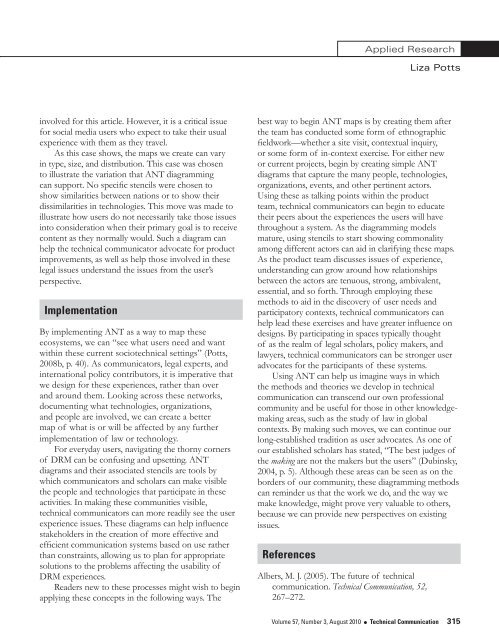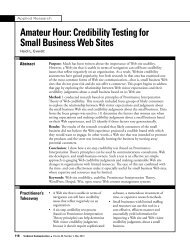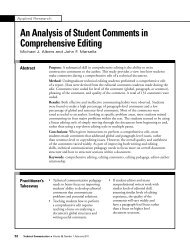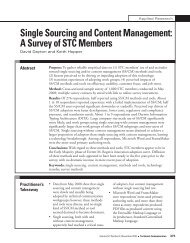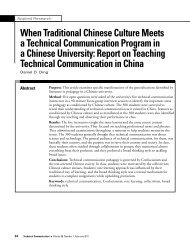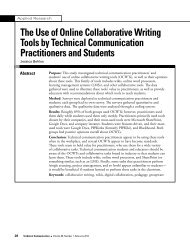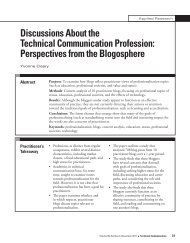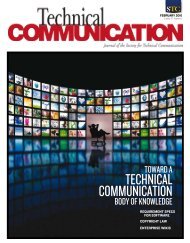Applied ResearchConsuming Digital Rightswhich they are physically located. Because copyright lawsare based on geographic location and not citizenship,Americans in Europe who access Pandora’s system willbe greeted by a message explaining this issue, listing thecountry in which they are located and their IP address.However, some users are now circumventingPandora’s system to access music outside the UnitedStates. Methods for doing so are listed across severalWeb sites; a simple Google search will turn up multipleways to circumvent the system. One method is tospoof the IP address through a proxy server. Spoofingrefers to faking the address to mask the identity of thecomputer. For example, users in Europe can spoof theirIP addresses to make it look as if they were locatedin the United States, allowing them to impersonate auser who is legally able to access Pandora. There arenumerous spoofing methods, such as man-in-themiddle,routing redirect, source routing, blind spoofing,and flooding (IBM, 2008). Without going into thetechnical details, such spoofing is complex enoughto require a more sophisticated level of technologicalexpertise than that of the average Internet user.However, the instructions postedon many sites have provided accessinformation for more proficient users,in theory widening the availability ofthese circumvention methods.Figure 9 illustrates how Pandorais accessed in the United States and inPortugal, highlighting the use of a proxyserver to spoof the system. By accessingthese proxy servers, the computer’s IPaddress is masked and replaced with aU.S.-based IP address.What is critical to note in thisdiagram is the lack of a human actor;rather than people, we have countriesand technologies. Geography trumpscitizenship in this user experience.Pandora’s international frequently askedquestions (FAQ) states that “only thecurrent location of the listener mattersfor international licensing law—notcitizenship, national origin, or countryof permanent residence” (Pandora,New YorkPandora2010c). Even payment does not allow the user tocircumvent this restriction, as Pandora’s FAQ states,“Similarly, source of revenue doesn’t matter—only thelegal right to play the music in a particular country”(Pandora, 2010c).While Pandora (2010b) states that they “don’thave the resources to pursue music-streaming licensingarrangements in many countries in the immediate future,but we do have the ultimate goal of being able to offerour service globally,” it seems that the legal issue ofcopyright is bumping up against the Genome Project’sinnovation. With more users, it is more likely that themusic Pandora is able to provide will be better targetedbecause of the participation features to vote on songswithin these channels.This argument returns us to Lessig (2002, 2008),whose work looked to balance the needs of copyrightholders with the necessity to innovate technologies.Although this may seem a current impossibility, theidea of binding experiences based on citizenship wouldalleviate the difficulties encountered during travel. Thedetails of such a solution are far too complicated andProxyServerFigure 9. Accessing Pandora across geographic boundariesLibson314 Technical Communication l Volume 57, Number 3, August 2010
Applied ResearchLiza Pottsinvolved for this article. However, it is a critical issuefor social media users who expect to take their usualexperience with them as they travel.As this case shows, the maps we create can varyin type, size, and distribution. This case was chosento illustrate the variation that ANT diagrammingcan support. No specific stencils were chosen toshow similarities between nations or to show theirdissimilarities in technologies. This move was made toillustrate how users do not necessarily take those issuesinto consideration when their primary goal is to receivecontent as they normally would. Such a diagram canhelp the technical communicator advocate for productimprovements, as well as help those involved in theselegal issues understand the issues from the user’sperspective.ImplementationBy implementing ANT as a way to map theseecosystems, we can “see what users need and wantwithin these current sociotechnical settings” (Potts,2008b, p. 40). As communicators, legal experts, andinternational policy contributors, it is imperative thatwe design for these experiences, rather than overand around them. Looking across these networks,documenting what technologies, organizations,and people are involved, we can create a bettermap of what is or will be affected by any furtherimplementation of law or technology.For everyday users, navigating the thorny cornersof DRM can be confusing and upsetting. ANTdiagrams and their associated stencils are tools bywhich communicators and scholars can make visiblethe people and technologies that participate in theseactivities. In making these communities visible,technical communicators can more readily see the userexperience issues. These diagrams can help influencestakeholders in the creation of more effective andefficient communication systems based on use ratherthan constraints, allowing us to plan for appropriatesolutions to the problems affecting the usability ofDRM experiences.Readers new to these processes might wish to beginapplying these concepts in the following ways. Thebest way to begin ANT maps is by creating them afterthe team has conducted some form of ethnographicfieldwork—whether a site visit, contextual inquiry,or some form of in-context exercise. For either newor current projects, begin by creating simple ANTdiagrams that capture the many people, technologies,organizations, events, and other pertinent actors.Using these as talking points within the productteam, technical communicators can begin to educatetheir peers about the experiences the users will havethroughout a system. As the diagramming modelsmature, using stencils to start showing commonalityamong different actors can aid in clarifying these maps.As the product team discusses issues of experience,understanding can grow around how relationshipsbetween the actors are tenuous, strong, ambivalent,essential, and so forth. Through employing thesemethods to aid in the discovery of user needs andparticipatory contexts, technical communicators canhelp lead these exercises and have greater influence ondesigns. By participating in spaces typically thoughtof as the realm of legal scholars, policy makers, andlawyers, technical communicators can be stronger useradvocates for the participants of these systems.Using ANT can help us imagine ways in whichthe methods and theories we develop in technicalcommunication can transcend our own professionalcommunity and be useful for those in other knowledgemakingareas, such as the study of law in globalcontexts. By making such moves, we can continue ourlong-established tradition as user advocates. As one ofour established scholars has stated, “The best judges ofthe making are not the makers but the users” (Dubinsky,2004, p. 5). Although these areas can be seen as on theborders of our community, these diagramming methodscan reminder us that the work we do, and the way wemake knowledge, might prove very valuable to others,because we can provide new perspectives on existingissues.ReferencesAlbers, M. J. (2005). The future of technicalcommunication. Technical Communication, 52,267–272.Volume 57, Number 3, August 2010 l Technical Communication 315
- Page 1 and 2:
AUGUST 2010Volume 57 Number 3SPECIA
- Page 3 and 4:
PresidentMichael A. HughesVice Pres
- Page 5 and 6:
VoLuME 57, NuMBER 3AUGUST 2010ISSN
- Page 7 and 8:
Guest EditorialKirk St.Amant and Ma
- Page 9 and 10:
Applied ResearchTechnical Communica
- Page 11 and 12:
Applied ResearchNicole St. Germaine
- Page 13 and 14:
Applied ResearchNicole St. Germaine
- Page 15 and 16:
Applied ResearchNicole St. Germaine
- Page 17 and 18:
Applied ResearchNicole St. Germaine
- Page 19 and 20:
Applied ResearchNicole St. Germaine
- Page 21 and 22: Applied ResearchNicole St. Germaine
- Page 23 and 24: Applied ResearchNicole St. Germaine
- Page 25 and 26: Applied TheoryTatiana BatovaIntrodu
- Page 27 and 28: Applied TheoryTatiana BatovaMoreno,
- Page 29 and 30: Applied TheoryTatiana BatovaThe Uni
- Page 31 and 32: Applied TheoryTatiana Batovadoctors
- Page 33 and 34: Applied TheoryTatiana BatovaTo addr
- Page 35 and 36: Applied TheoryTatiana Batovathe loc
- Page 37 and 38: Applied TheoryTatiana BatovaJohnson
- Page 39 and 40: Applied TheoryTatiana BatovaInterna
- Page 41 and 42: Applied TheoryMcKee and PorterIntro
- Page 43 and 44: Applied TheoryMcKee and PorterFor e
- Page 45 and 46: Applied TheoryMcKee and Porterpubli
- Page 47 and 48: Applied TheoryMcKee and PorterBecau
- Page 49 and 50: Applied TheoryMcKee and Porterof th
- Page 51 and 52: Applied TheoryMcKee and Porterwith
- Page 53 and 54: Applied TheoryMcKee and PorterA Cop
- Page 55 and 56: Applied TheoryMcKee and PorterConte
- Page 57 and 58: Applied TheoryMcKee and PorterWalto
- Page 59 and 60: Applied ResearchLiza PottsIntroduct
- Page 61 and 62: Applied ResearchLiza Pottsdoes not
- Page 63 and 64: Applied ResearchLiza PottsUser’s
- Page 65 and 66: Applied ResearchLiza Pottsactors, t
- Page 67 and 68: Applied ResearchLiza PottsDRM has a
- Page 69 and 70: Applied ResearchLiza Pottsmake bett
- Page 71: Applied ResearchLiza PottsOne viewe
- Page 75 and 76: Applied ResearchLiza PottsHayhoe, G
- Page 77 and 78: Applied ResearchInternational Fair
- Page 79 and 80: Applied ResearchTyAnna K. Herringto
- Page 81 and 82: Applied ResearchTyAnna K. Herringto
- Page 83 and 84: Applied ResearchTyAnna K. Herringto
- Page 85 and 86: Applied ResearchTyAnna K. Herringto
- Page 87 and 88: Applied ResearchTyAnna K. Herringto
- Page 89 and 90: Book ReviewsWriting Successful Scie
- Page 91 and 92: Book ReviewsThe Process: Business P
- Page 93 and 94: Book ReviewsHCI Beyond the GUI: Des
- Page 95 and 96: Book ReviewsOrigins of the Specious
- Page 97 and 98: Book Reviewsgenre, and process, top
- Page 99 and 100: Book ReviewsPart One goes from the
- Page 101 and 102: Book Reviewsrather than writers, an
- Page 103 and 104: Book ReviewsHow to Write Fast Under
- Page 105 and 106: Book Reviewsmanagement system (CMS)
- Page 107 and 108: Book Reviewsnearly strangled when h
- Page 109 and 110: Book Reviewsinteractive TV model)
- Page 111 and 112: Book ReviewsOtherwise, Beech shows
- Page 113 and 114: Book Reviewssuch as blog, I found m
- Page 115 and 116: Book Reviewsemployees and effective
- Page 117 and 118: Recent & RelevantSherry Southard, E
- Page 119 and 120: Recent & RelevantRecent & RelevantC
- Page 121 and 122: Recent & RelevantRecent & RelevantE
- Page 123 and 124:
Recent & Relevantworking in a langu
- Page 125 and 126:
Recent & RelevantWhat’s the big d
- Page 127 and 128:
Recent & RelevantScientific Writing
- Page 129 and 130:
Recent & Relevantapplicability. Man
- Page 131:
Did You Missthe Summit?Don’t miss


